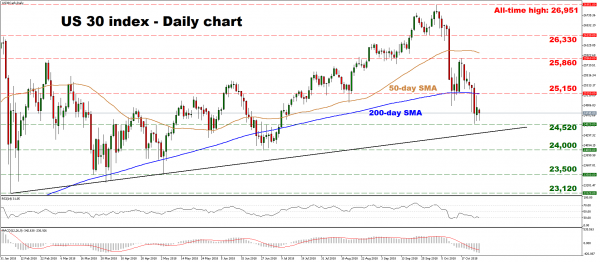The US 30 index recorded considerable losses in recent weeks, touching a 3½-month low on October 24, and falling below both its 50- and 200-day simple moving averages (SMA). Hence, the short-term bias has turned negative, though the fact that the market is still trading above an uptrend support line drawn from the lows of February 6 keeps the medium-term outlook neutral for now.
Taking a look at short-term oscillators, the RSI – already below its neutral 50 line – is currently testing its oversold 30 level. Although its detecting accelerating downside momentum, the fact that it is nearing oversold waters suggests that a near-term rebound shouldn’t be ruled out. Meanwhile, the MACD is negative and below its red trigger line.
Further declines in the index could encounter a first line of support near the crossroads of the 24,520 level and the aforementioned uptrend line. A clear close below this area, would turn the medium-term outlook negative as well, likely setting the stage for more declines – initially towards the round figure of 24,000. Even lower, the bears could stall near the 23,500 hurdle, marked by the lows of May 3.
On the flipside, a rebound may find preliminary resistance near the 25,150 line, where the 200-day SMA is currently located as well. An upside break of this zone would shift the short-term bias back to neutral, potentially paving the way for a test of the 25,860 barrier – this being the high of October 17. Even higher, sell orders may be found around 26,330, an area defined by the inside swing low of September 27.
All in all, the short-term outlook is negative, and a decisive close below the 24,520 territory and the uptrend line would shift the medium-term outlook to negative as well.













